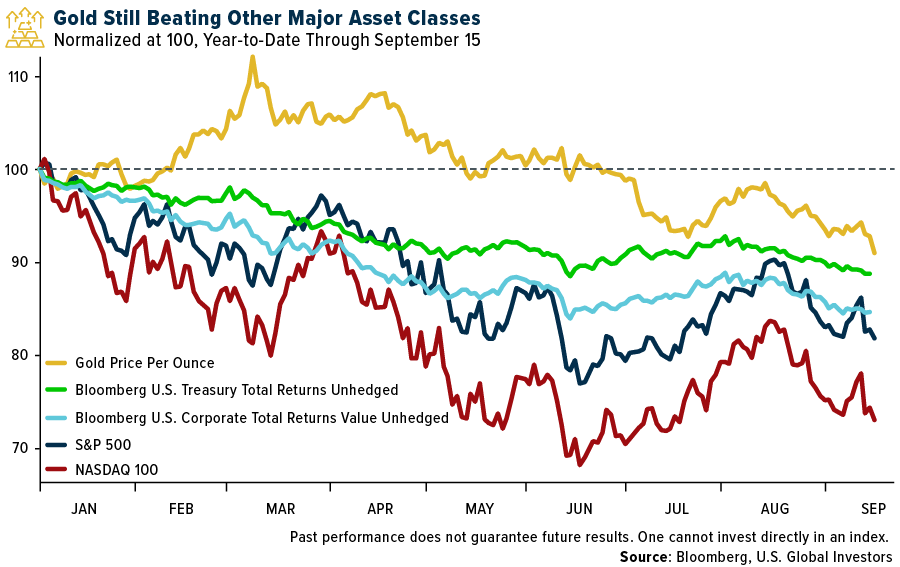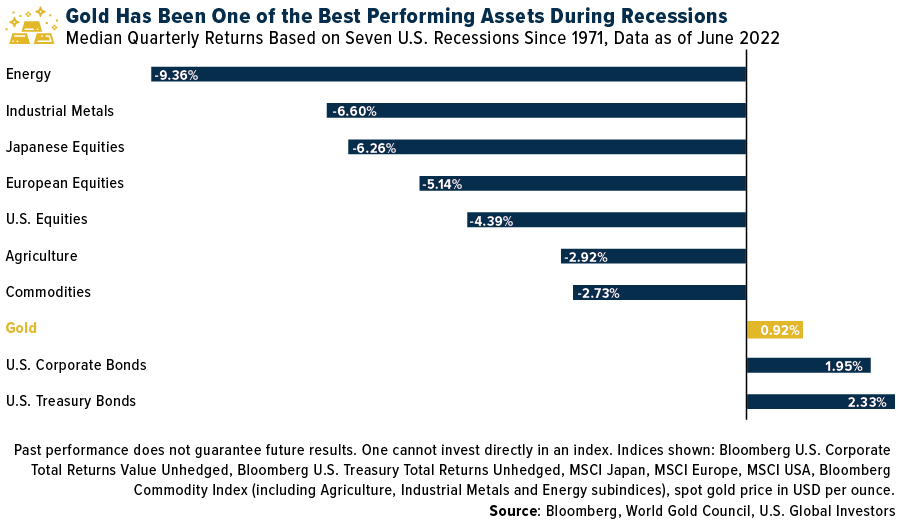Gold bullion has given back approximately 8% year-to-date through September 16, making it one of the best performing assets of 2022 so far. The precious metal closed the week at a nearly two-and-a-half-year low of $1,665 an ounce, even as inflation remains historically high and recession fears persist.
Some investors may read this and jump to the conclusion that gold is no longer a valuable asset during times of economic and financial uncertainty, but they would be mistaken. Although the metal is down for the year, it’s nevertheless outperformed most major asset classes including Treasury bonds, U.S. corporate bonds, the S&P 500 and tech stocks. As such, the metal has helped investors mitigate losses in other areas of their portfolio this year.

Weighing on gold (and other assets) is the U.S. dollar, which has surged to its highest relative strength in 20 years due in large part to the Federal Reserve’s aggressive rate hikes. Earlier this month, the U.S. Dollar Index touched 110, a level unseen since May 2002.
Gold hasn’t ordinarily done well in a strong-dollar environment, but the last time the greenback was at 110, the yellow metal was trading at around $300 an ounce, or $1,360 less than its current price. We believe this underlines gold’s resilience in the face of tough macro forces.
Gold’s Performance During Past Recessions
The latest report by the World Gold Council (WGC) makes the case that gold could also be a powerful investment during a potential economic recession. The London-based group compared the performance of a number of asset classes during the past seven U.S. recessions going back to 1971, and it found that gold performed the best on average aside from government and corporate bonds. Returns were 0.92% on average compared to 1.95% for corporate bonds and 2.33% for Treasury bonds.

With most global central banks raising interest rates in an effort to tamp down inflation, recession fears are mounting. Granted, past performance is no guarantee of future results, but the strategy of buying and holding physical gold has worked well so far this year in helping investors stanch the losses in their equity and fixed-income positions.
Looking for other ways to invest in gold? We’re pleased to offer the U.S. Global GO GOLD and Precious Metal Miners ETF (NYSE: GOAU), which provides investors access to companies engaged in the production of precious metals either through active (mining or production) or passive (owning royalties or production streams) means.
Explore GOAU by clicking here!
PAST PERFORMANCE IS NO GUARANTEE OF FUTURE RESULTS.
All opinions expressed and data provided are subject to change without notice. Some of these opinions may not be appropriate to every investor.
Please carefully consider a fund’s investment objectives, risks, charges, and expenses. For this and other important information, obtain a statutory and summary prospectus for GOAU here. Read it carefully before investing.
Investing involves risk, including the possible loss of principal. Shares of any ETF are bought and sold at market price (not NAV), may trade at a discount or premium to NAV and are not individually redeemed from the funds. Brokerage commissions will reduce returns.
Because the funds concentrate their investments in specific industries, the funds may be subject to greater risks and fluctuations than a portfolio representing a broader range of industries. The funds are non-diversified, meaning they may concentrate more of their assets in a smaller number of issuers than diversified funds.
The funds invest in foreign securities which involve greater volatility and political, economic and currency risks and differences in accounting methods. These risks are greater for investments in emerging markets. The funds may invest in the securities of smaller-capitalization companies, which may be more volatile than funds that invest in larger, more established companies.
The performance of the funds may diverge from that of the index. Because the funds may employ a representative sampling strategy and may also invest in securities that are not included in the index, the funds may experience tracking error to a greater extent than funds that seek to replicate an index.
The funds are not actively managed and may be affected by a general decline in market segments related to the index. Gold, precious metals, and precious minerals funds may be susceptible to adverse economic, political, or regulatory developments due to concentrating in a single theme. The prices of gold, precious metals, and precious minerals are subject to substantial price fluctuations over short periods of time and may be affected by unpredicted international monetary and political policies. We suggest investing no more than 5% to 10% of your portfolio in these sectors.
Fund holdings and allocations are subject to change at any time. Click to view fund holdings for GOAU.
Distributed by Quasar Distributors, LLC. U.S. Global Investors is the investment adviser to GOAU.
Investors cannot invest directly in an index. The Bloomberg US Treasury Index measures US dollar-denominated, fixed-rate, nominal debt issued by the US Treasury. Treasury bills are excluded by the maturity constraint but are part of a separate Short Treasury Index. The Bloomberg US Corporate Bond Index measures the investment grade, fixed-rate, taxable corporate bond market. It includes USD denominated securities publicly issued by US and non-US industrial, utility and financial issuers. The NASDAQ-100 Index is a modified capitalization-weighted index of the 100 largest and most active non-financial domestic and international issues listed on the NASDAQ. The S&P 500 is widely regarded as the best single gauge of large-cap U.S. equities and serves as the foundation for a wide range of investment products. The index includes 500 leading companies and captures approximately 80% coverage of available market capitalization. The MSCI Japan Index is a free-float weighted equity JPY index. It was developed with a base value of 100 as of December 31, 1969. The MSCI Europe Index in EUR is a free-float weighted equity index measuring the performance of Europe Developed Markets. It was developed with a base value of 100 as of December 31, 1998. The MSCI USA Index is a free-float weighted equity index. It was developed with a base value of 100 as of December 31, 19`69. The Bloomberg Commodity Index is calculated on an excess return basis and reflects commodity futures price movements. The index rebalances annually weighted 2/3 by trading volume and 1/3 by world production and weight-caps are applied at the commodity, sector and group level for diversification. The U.S. Dollar Index indicates the general international value of the USD. The USDX does this by averaging the exchange rates between the USD and major world currencies.
